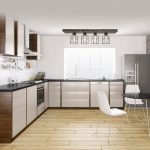The right lighting can make a huge difference in your kitchen. Not only does proper lighting make it easier to see what you’re doing while cooking and cleaning, but it can also enhance the overall design and ambiance of the space. There are several different types of lighting to consider when designing your kitchen, including task lighting, ambient lighting, and accent lighting.
Task lighting is essential in the kitchen, as it provides focused light in areas where you need it most. This type of lighting is typically placed above work surfaces like countertops, islands, and stovetops to ensure that you have adequate and consistent light while cooking. Under-cabinet lighting is a popular option for task lighting, as it illuminates the workspace without creating shadows or glare.
Ambient lighting is used to create a warm and inviting atmosphere in the kitchen. This type of lighting typically comes from ceiling fixtures, such as recessed lights, track lighting, or pendant lights. Ambient lighting should be evenly distributed throughout the room to ensure that the space feels bright and welcoming. Dimmer switches are a great addition to ambient lighting, as they allow you to adjust the brightness to suit different activities and moods.
Accent lighting is used to highlight specific features or areas in the kitchen, such as artwork, architectural details, or decorative elements. This type of lighting adds depth and visual interest to the room, creating a more dynamic and visually appealing space. Accent lighting can be achieved with wall sconces, track lighting, or LED strip lights placed strategically around the kitchen.
Natural light is an often-overlooked but important aspect of kitchen lighting. If possible, maximize the amount of natural light in your kitchen by incorporating large windows, skylights, or glass doors. Natural light not only brightens the space but also provides a connection to the outdoors, creating a more open and inviting atmosphere.
When planning your kitchen lighting design, it’s important to consider the layout and functionality of the space. Make sure to position task lighting in key areas where you’ll be working most frequently, such as above the sink, stove, and food prep areas. Additionally, layering different types of lighting will provide versatility and flexibility, allowing you to adjust the brightness and mood of the room as needed.
In conclusion, the right lighting can transform your kitchen into a functional and beautiful space. By incorporating task lighting, ambient lighting, accent lighting, and natural light, you can create a well-lit and inviting environment for cooking, dining, and entertaining. Take the time to carefully plan and design your kitchen lighting to ensure that it meets your needs and enhances the overall aesthetic of your space.
 efistu.com Home Decor
efistu.com Home Decor
















